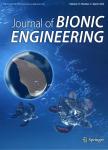Fabrication of 3D Printed PCL/PEG Polyblend Scaffold Using Rapid Prototyping System for Bone Tissue Engineering Application
Fabrication of 3D Printed PCL/PEG Polyblend Scaffold Using Rapid Prototyping System for Bone Tissue Engineering Application作者机构:Department of Nature-Inspired Nanoconvergence Systems Korea Institute of Machinery and Materials 156 Gajeongbuk-ro Yuseong-gu Daejeon 34103 Republic of Korea Department of Dental Materials School of Dentistry Kyung Hee University 26 Kyungheedae-ro Dongdaemun-gu Seou102447 Republic of Korea
出 版 物:《Journal of Bionic Engineering》 (仿生工程学报(英文版))
年 卷 期:2018年第15卷第3期
页 面:435-442页
核心收录:
学科分类:0710[理学-生物学] 0831[工学-生物医学工程(可授工学、理学、医学学位)] 08[工学] 0817[工学-化学工程与技术] 081701[工学-化学工程] 0802[工学-机械工程] 0836[工学-生物工程] 080201[工学-机械制造及其自动化] 0702[理学-物理学]
基 金:supported by a grant from the Korean Health Technology R & D Project Ministry of Health & Welfare and by the Industrial Strategic technology development program Ministry of Trade, industry and Energy, Republic of Korea
主 题:polycaprolactone polyethylene glycol polyblend 3D printing porosity bone tissue engineering
摘 要:Three-dimensional (3D) printing is a novel process used to manufacture bone tissue engineered scaffolds. This process allows for easy control of the architecture at the micro structure. However, the scaffold properties are typically limited in terms of cellular activity at the scaffold surface due to the printed materials properties. In this study, we developed a polycaprolactone (PCL) blended with polyethylene glycol (PEG) 3D printed scaffold using a rapid prototyping system. The manufactured scaffolds were then washed out to form small pores on the surface in order to improve the scaffolds hydrophilicity. We analyzed the resultant material by using Scanning Electron Microscopy (SEM), water absorption, water contact angle, in vitro WST-1, and the Bradford assay. Additionally, cells incubated on the fabricated scaffolds were visualized by Confocal Laser Scanning Microscopy (CLSM). The developed scaffolds exhibited small pores on the strand surface which served to increase hydrophilicity as well as improve cellular proliferation and increase total protein content. Our findings suggest that the presence of small pores on the scaffolds can be used as an effective tool for improving implant cellular interaction. This research indicates that these modified scaffolds can be considered useful for bone tissue engineering applications to improve human health.



